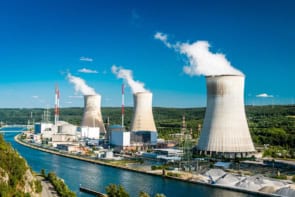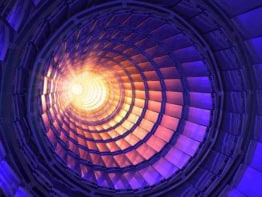
Oil tankers fitted with neutrino detectors, hundreds of thousands of tonnes in mass, could be floated offshore to check for undeclared nuclear fission reactors. That’s the idea of physicists in France, who have proposed the Secret Neutrino Interactions Finder (SNIF) as a way of enforcing the nuclear non-proliferation treaty – although some experts doubt its feasibility.
Currently, fission reactors over the world are monitored by the United Nations’ International Atomic Energy Agency (IAEA), based in Vienna. The IAEA uses several “near-field” tools to make sure reactors are running legally, from CCTV-type cameras to metallic or fibre-optic networks that can detect when fuel is being loaded. In some cases, the agency installs thermal monitors to check that reactors are not being operated for too long, as might be required for the production of bomb-making plutonium.
Another, perhaps more fail-safe way to monitor reactors would be to detect the nearby levels of anti-neutrinos – light particles that are emitted copiously in nuclear-fission reactions. Because the flux of anti-neutrinos arriving at a certain area is proportional to the power of a reactor and its proximity, the anti-neutrino level at any point should be an indicator of what fission reactions are taking place nearby.
Neutrino oscillations
But, as researchers discovered almost a decade ago, the science is more complicated. Neutrinos have a small, finite mass – not zero, as was previously thought – and are able to oscillate from one type to another. This means that a detector looking for one type of anti-neutrino would always detect fewer than expected, because some of them oscillate into different types before arrival.
Thierry Lasserre at the French Alternative Energies and Atomic Energy Commission says that improvements in the understanding of neutrino oscillation have enabled his group to explore the use of anti-neutrino detectors for “far-field” reactor monitoring. Lasserre and his colleagues have calculated how anti-neutrino fluxes fall with distance from a reactor, taking into account oscillations. They have then analysed all the other sources of anti-neutrinos – 200 nuclear power stations over the globe – to produce a map of background anti-neutrino levels.
In a final calculation, Lasserre’s group showed that a neutrino detector would need to be sunk just 500 m or more underwater to prevent catching any cosmic rays, which would confuse the signal. The researchers think that, for monitoring fission reactions in a radius of 100–500 km, a detector would need a scintillator mass of 1034 free protons – in the order of a hundred thousand tonnes.
Friendly and clandestine activities
John Learned, a physicist at the University of Hawaii, US, who first suggested using neutrino detectors for global fission-reactor monitoring, believes the group has performed some “excellent” calculations, but notes that the SNIF idea is not totally new. He adds, however, “With a network of monitors one can record the activity of a group of reactors, perhaps some friendly ones, and some clandestine reactors. With various methods under development we can do a better job, even than indicated in this paper.”
Others are not so sure. Andrew Monteith of the IAEA’s Novel Technologies Unit says that the IAEA is at present only interested in neutrino detectors for near-field detection, because only that is within its current remit. “The far-field approach that’s discussed in the paper has never really been an official part of our thinking,” Monteith explains. “We’re taking it on a stage-by-stage basis, and the near-field one is certainly more realistic for us, in terms of cost and deployment.”
Expensive solution?
Julian Whichello, head of the Novel Technologies Unit, believes Lasserre’s SNIF detector could cost in the region of $100 million – almost the same as the IAEA’s entire budget for global verification of fission reactors. “This is something that’s well and truly outside of the current budget of the agency,” he says.
Still, Lasserre explains that his group’s goal was to explore the scientific possibilities rather than have political influence. “This is very futuristic,” he says. “It’s huge, it will cost a lot of money and it’s a difficult effort. Technically it would be possible in the next 30 years, but I’m not aware of any programme in the world to build such devices.”
The research is available at arXiv:1011.3850.



